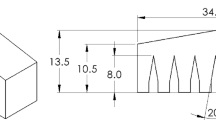Abstract
Micro injection moulding is an established manufacturing technology for producing thermoplastic micro parts. For increasing part complexity, an assembly injection moulding of micro parts offers new strategies for process automatization and part design. However, due to modified process conditions in micro injection moulding there are still a lot of questions for example regarding the part or process design. This paper investigates the influence of mould temperature on the morphology development of the first and second component as well as the resulting bonding strength of both components. The varied process conditions affect the process induced structure in the first and the second component as well the resulting bonding strength which was determined in tensile tests.








Similar content being viewed by others
References
Angelov AK, Coulter JP (2004) Micromolding product manufacture: a progress report. SPE Proceedings ANTEC, Chicago, pp 748–751
Bibber DM (2004) Micro molding challenges. SPE Proceedings ANTEC, Chicago, pp 3703–3711
Dormann B, Juettner G (2009) High-precision miniatures. Kunststoffe Int 99:22–24
Drummer D, Ehrenstein GW, Hopmann C, Vetter K, Meister S, Fischer T, Piotter V, Prokop J (2012) Innovative process technologies for manufacturing thermoplastic micro parts—analysis and comparative assessment. J Plast Technol 8:439–467
Ehrenstein GW, Riedel G, Trawiel P (2004) Thermal analysis of plastics. Hanser, Munich
Farrugia P, Vella P, Said L (2012) Design for micro insert moulding: A review. ASME Proceedings, Chicago, pp 835–842. doi:10.1115/DETC2012-70571
Ferreira T, Lopes PE, Pontes AJ, Paiva MC (2014) Microinjection molding of polyamide 6. Polym Adv Technol 25:891–895. doi:10.1002/pat.3322
Galimberti D, Quarti C, Milani A, Brambilla L, Civalleri B, Castiglioni C (2013) IR spectroscopy of crystalline polymers from ab initio calculations: Nylon 6,6. Vib Spectrosc 66:83–92. doi:10.1016/j.vibspec.2013.02.005
Giboz J, Copponnex T, Mélé P (2007) Microinjection molding of thermoplastic polymers: a review. J Micromech Microeng 17:96–109. doi:10.1088/0960-1317/17/6/R02
Giboz J, Copponnex T, Mélé P (2009) Microinjection molding of thermoplastic polymers: morphological comparison with conventional injection molding. J Micromech Microeng 19:1–12. doi:10.1088/0960-1317/19/2/025023
Haberstroh E, Brandt M (2002) Determination of mechanical properties of thermoplastics suitable for micro systems. Macromol Mater Eng 287:881–888. doi:10.1002/mame.200290023
Haertig T (2013) Stoffübertragung beim Spritzgießen. PhD thesis, University Chemnitz
Jungmeier A (2010) Struktur und Eigenschaften spritzgegossener, thermoplastischer Mikroformteile. PhD thesis, University Erlangen-Nuernberg
Kohan MI (1995) Nylon plastics handbook. Hanser Gardner Publications, Munich
Kuehnert I (2005) Grenzflächen beim Mehrkomponentenspritzgießen. PhD thesis, University Chemnitz
Meister S, Drummer D (2013) Influence of manufacturing conditions on measurement of mechanical material properties on thermoplastic micro tensile bars. Polym Testing 32:432–437. doi:10.1016/j.polymertesting.2012.12.006
Meister S, Jungmeier A, Drummer D (2012) Long term properties of injection moulded micro-parts. Macromol Mater Eng 297:994–1004. doi:10.1002/mame.201100379
Meister S, Vetter K, Ehrenstein GW, Drummer D (2013) Measurement of mechanical material properties for micro parts on injection moulded micro tensile bars.”. J Plast Technol 9:74–99
Michaeli W, Kamps T (2008) Micro assembly injection moulding with plasma treated inserts. Microsyst Technol 14:1903–1907. doi:10.1007/s00542-008-0684-2
Michaeli W, Opfermann D (2005) Bonding strength in micro injection assembly moulding. SPE Proceedings ANTEC, Boston, pp 11–15
Michaeli W, Opfermann D (2006) Micro assembly injection moulding. Microsyst Technol 12:616–619. doi:10.1007/s00542-006-0081-7
Michaeli W, Spennemann A, Gaertner R (2002) New plastification concepts for micro injection moulding. Microsyst Technol 8:55–57. doi:10.1016/j.polymertesting.2012.12.006
Michaeli W, Opfermann D, Kamps T (2007) Advances in micro assembly injection moulding for use in medical systems. Int J Adv Manuf Technol 33:206–211
Schmiederer D, Schmachtenberg E (2006) Einflüsse auf die Eigenschaften kleiner und dünnwandiger Spritzgussteile. J Plast Technol 2:1–21
Schuck M, Kuehnert I, Schmachtenberg E (2008) Advanced compatibility matrices by multi-component injection molding process. SPE Proceedings ANTEC, Milwaukee, pp 349–353
Xie L, Ziegmann G (2010) Effect of gate dimension on micro injection molded weld line strength with polypropylene (PP) and high-density polyethylene (HDPE). Int J Adv Manuf Technol 48:71–81. doi:10.1007/s00170-009-2276-4
Acknowledgments
The authors would like to thank the Bavarian Research Foundation for funding the work. We also extend our gratitude to our industrial partners Werkzeugbau Hofmann GmbH, Oechsler AG, Single Temperiertechnik GmbH, Arburg GmbH & Co. and BASF SE for providing equipment and material. They further thank Mrs. Pia Trawiel for supporting the measurements and critical discussions.
Author information
Authors and Affiliations
Corresponding author
Rights and permissions
About this article
Cite this article
Meister, S., Drummer, D. Micro assembly injection moulding with variothermal mould tempering. Microsyst Technol 23, 1017–1025 (2017). https://doi.org/10.1007/s00542-016-2820-8
Received:
Accepted:
Published:
Issue Date:
DOI: https://doi.org/10.1007/s00542-016-2820-8




